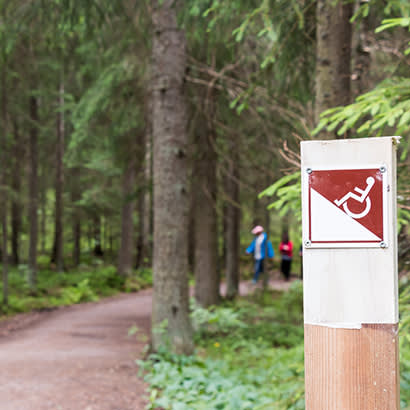
For an enhanced digital experience, read this story in the ezine.
Having worked as the Americans with Disabilities Act (ADA) coordinator for the Fairfax County Park Authority (FCPA) for the past 19 years, I can attest that one of our biggest challenges in both the indoor and outdoor environments has been the ability to ensure 100 percent compliance with ADA standards. With more than 400 facilities, 24,000 acres of parkland and 1,145,670 customers at last count, here’s what I have found to be best practices.
Standards vs. Guidelines
There’s always that project manager who thinks, for example, “We don’t have to follow the trail accessibility guidelines because they are not required.” While there’s an inkling of truth to that statement, remember all guidelines eventually become standards after adoption. Not only does this mindset save you money in the long run versus having to come back and retrofit for compliance down the road, but also by following the guidelines you are meeting the spirit of the law by ensuring persons with disabilities can participate in your programs and services. In addition, why risk the negative publicity? Use the latest guidelines to level the playing field, which is your ultimate goal!
Planning
Identifying all of the applicable ADA standards and guidelines in a renovation or new construction is paramount to getting it right the first time. Dedicate a page or two of your plans to those ADA components and detail those standards to help ensure your contractor and project manager are clear on those expectations.
When making renovations, at a minimum and unless all your ADA obligations are satisfied, you should spend 20 percent of your project budget on accessibility needs. Starting outside in, think logically and prioritize:
- Is the accessible parking compliant?
- Is the route to the facility accessible?
- Is the restroom inside compliant?
- Are there both a high and low water fountain?
- Would we be better served by an automatic door opener in the lobby or one for accessing the restroom?
Quality Assurance
Both during construction and after, someone should be checking the work for quality assurance. Below are some suggestions for producing a successful project outcome:
- Checklists are excellent tools for guidance and documentation and can be found at the New England ADA Center website.
- For accessible routes, it is critical to communicate with your contractor to ensure your base coat (prior to your concrete/asphalt finish) will meet expectations for a slope with an absolute maximum base grade of 4.5 percent and cross slope of 1.5 percent. The standard for assessing accessible routes is to break the route into four-foot sections (if using a four-foot level), then cut the route in half lengthwise and measure each section into a consistent number of rectangular sections, determining both slope and cross slope. Total your readings and then figure the average by dividing the number of readings documented.
- For accessible parking, ensuring a 2 percent slope in all directions is critical for achieving usability. If your parking space is in a gravel parking lot, ensure there is periodic maintenance performed to sweep the gravel off the space. The standard for measuring accessible parking spaces is to break the space into nine squares, again measuring both slope and cross slope for each. To determine compliance, total your slope readings and then divide by 9 to get your overall slope score.
- Ensure your maintenance staff are checking the opening force of your interior doors monthly. Five pounds of pressure or less is critical for ensuring seamless usability.
- Use your resources! The Mid-Atlantic ADA Information Center has been an invaluable resource over the years
The experience here at FCPA has been overwhelmingly positive thanks to staff support and a healthy allocation of resources. While 100 percent compliance is still a ways down the road, we have built a solid foundation for the future.
Gary Logue is ADA Coordinator for Fairfax County Park Authority

